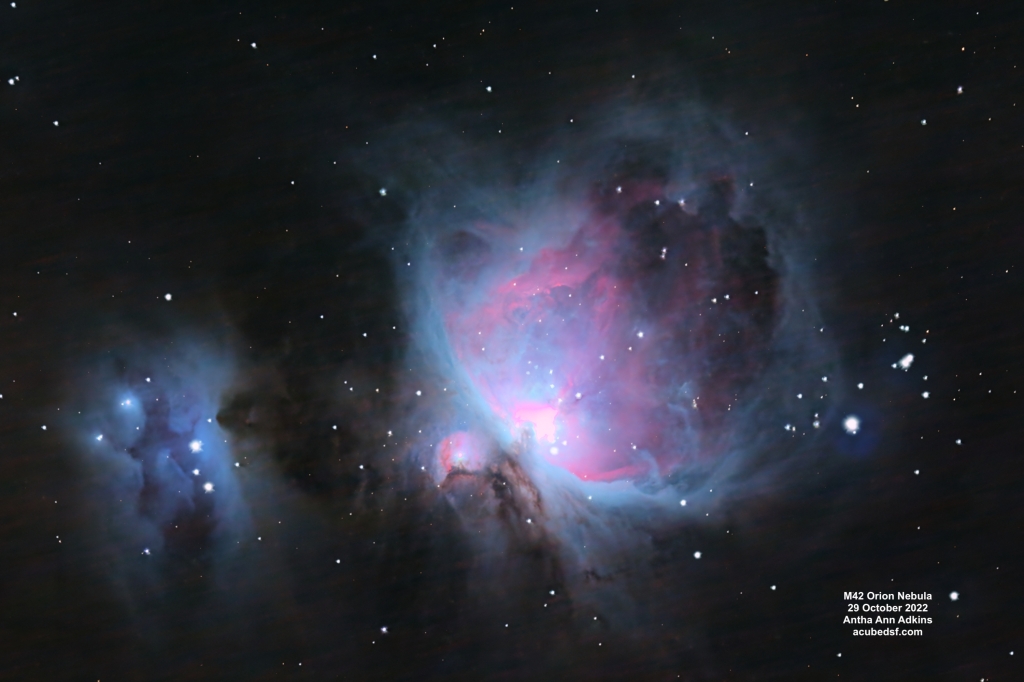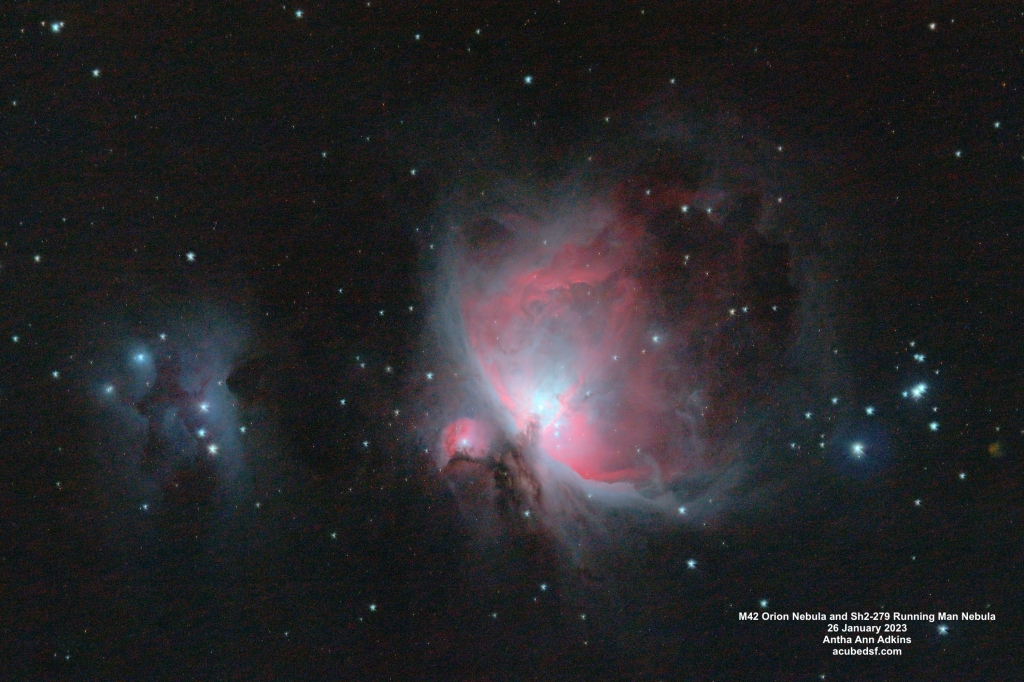
I’ve bought some new astrophotography gear, so it’s been cloudy for a month (LOL), and I’ve had the opportunity to go back and process some old data of a favorite Deep Space Object (DSO), M42, The Orion Nebula.
The Orion Nebula is an emission nebula of ionized hydrogen gas where star formation is taking place. It’s located in the Milky Way, approximately 1344 light years away, and it’s approximately 24 light years across, giving it an apparent size of 1 degree.
The Orion Nebula is one of my favorite DSOs because it is bright and can be enjoyed so many ways. It is visible to the naked eye as the middle “star” in Orion’s sword. It can be seen to be a fuzzy object with binoculars. The trapezium of stars in the core can be seen even with a small telescope like mine. And astrophotography brings out its full size and color.
The nebula to the left of the Orion Nebula is called the Running Man nebula. Can you see the dark running man? The Running Man nebula is a reflection nebula, reflecting the light of local stars. It is approximately 1500 light years away, and approximately 15 light years across, giving it an apparent size of 34 arc-minutes.
The image above was made from 66 minutes of data (22 3 minute images) from the fabulous dark skies of Dell City, Texas.
Camera geek info:
- Canon EOS 60D in manual mode, 3 minute exposure, ISO 1600
- Intervalometer
- Williams Optics Zenith Star 73 III APO telescope
- Williams Optics Flat 73A
- iOptron CEM40
- Dell City, Texas Bortle 2-3 dark skies
Frames:
- October 28, 2022
- 22 3 minute lights (66 minutes total)
- 10 6 second darks
Processing geek info:
- PixInsight
- BlurXterminator
- NoiseXterminator
- StarXTerminator
- Generalized Hyperbolic Stretch
The Orion Nebula shows my own astrophotography learning curve. I imaged it in 2019 with just a DSLR, telephoto lens, and a sky tracker. And I processed a single image from the 2022 set used above before I learned how to use PixInsight. This set, you’ll notice, did not include the flat and flat dark calibration frames I use now.
Not having all the calibration frames worked out OK in Dell City … but no such much from my light-polluted skies in suburban Friendswood, Texas. Here is what I get with no flat calibration frames (note all the dark spots not calibrated out), no light pollution filter, and my current knowledge of PixInsight. Yes, I could have lost some of the nebula detail and hidden the dark spots, but that’s a cost to not having good calibration frames. Since it’s fast and easy to take flats, they’re totally worth it.

Camera geek info:
- Canon EOS 60D in manual mode, 119 second exposure, ISO 200
- Intervalometer
- Williams Optics Zenith Star 73 III APO telescope
- Williams Optics Flat 73A
- iOptron CEM40
- Friendswood, Texas Bortle 7-8 suburban skies
Frames:
- November 26, 2022
- 27 119 second lights (53.55 minutes total)
- 6 119 second darks
Processing geek info:
- PixInsight
- BlurXterminator
- NoiseXterminator
- StarXTerminator
- Generalized Hyperbolic Stretch
A couple of months after I took the previous image, I learned what calibration frames I needed. Here is what I got with data taken from my suburban driveway with calibration frames, a light pollution filter, and my current knowledge of PixInsight.

Camera geek info:
- Canon EOS 60D in manual mode, 19 second exposure, ISO 800
- Intervalometer
- Williams Optics Zenith Star 73 III APO telescope
- Williams Optics Flat 73A
- SkyTech 2” LPRO-MAX CCD Filter
- iOptron CEM40
- Friendswood, Texas Bortle 7-8 suburban skies
Frames:
- January 26, 2023
- 143 19 second lights (45.3 minutes total)
- 25 0.02 second flats
- 21 0.02 second flat darks
- 47 20 second darks
Processing geek info:
- PixInsight
- BlurXterminator
- NoiseXterminator
- StarXTerminator
- Generalized Hyperbolic Stretch
These three images had similar total exposure lengths. The Dell City image, with the longest total exposure time, highest ISO, and darkest skies, is the best of the three. The slightly shorter November 2022 image from Friendswood is flawed due to the lack of calibration frames. The even shorter January 2023 image from Friendswood is starting to show noise in the background. But the nebulae themselves are beautiful!
As I said, I’ve recently gotten some new astrophotography gear, and first light on it was the Orion Nebula. Stay tuned for the results!!
